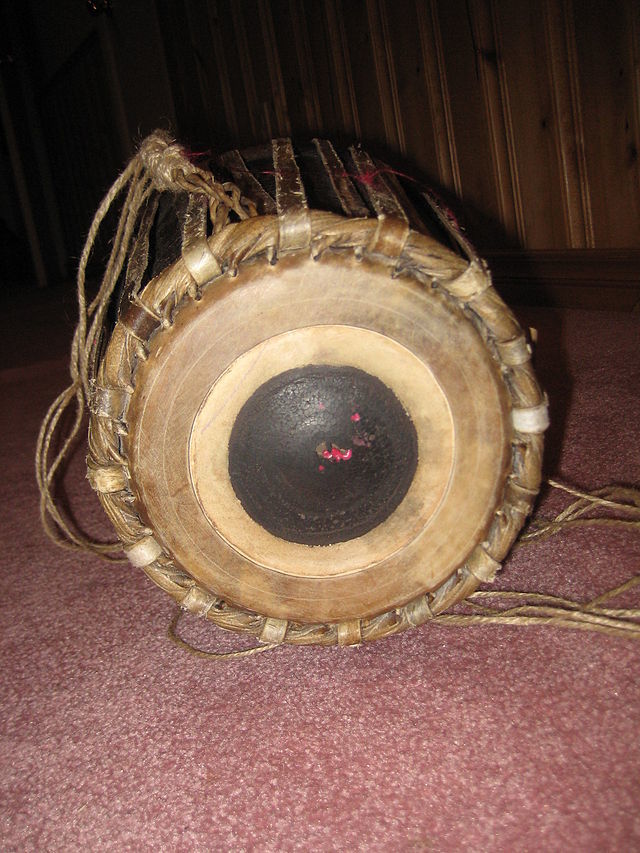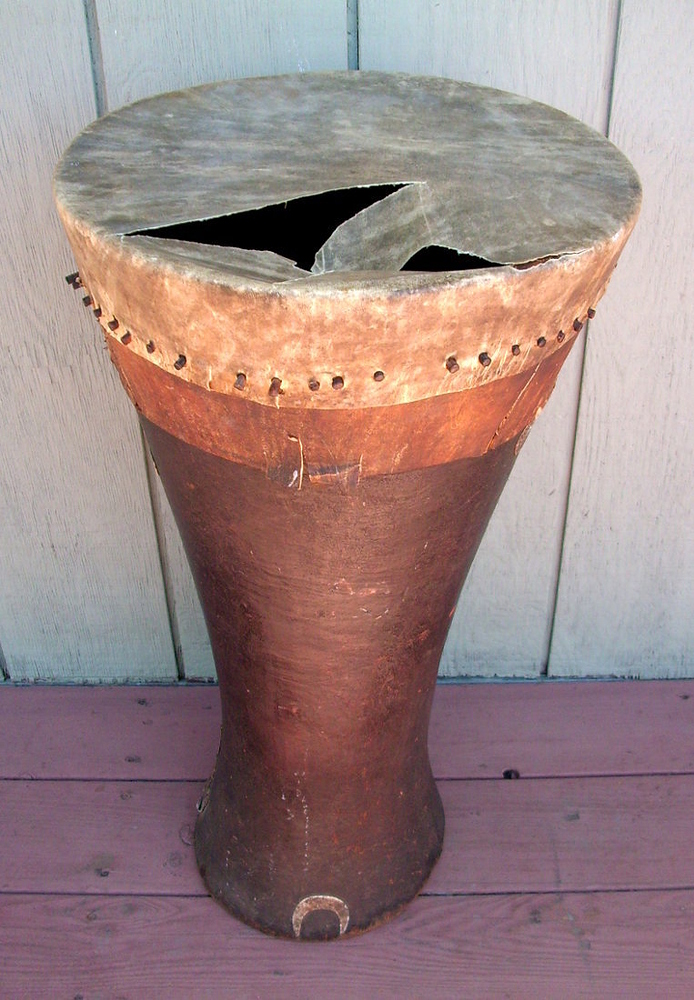Bhikkhu Sujato: On Drums and Pegs
In SN 20.7 we have a memorable little story about a people who used a drum and kept repairing it until the original had vanished. This is used as a simile for the disappearance of the Dhamma. As people stop reading and studying the suttas, gradually the true teaching will vanish. There’s a Chinese parallel at SA 1258.
As often happens in the suttas, the overall intent of the story is clear, but the details are much less so. In fact as a musician I have always found the translations somewhat puzzling, so a bit of research is in order.
The commentary to the text has a long and fun background story involving a huge crab and a mountain troll, but I will leave that aside.
Let’s start with the text and Ven Bodhi’s translation to get orientated:
Bhūtapubbaṃ, bhikkhave, dasārahānaṃ ānako nāma mudiṅgo ahosi. Tassa dasārahā ānake ghaṭite aññaṃ āṇiṃ odahiṃsu. Ahu kho so, bhikkhave, samayo yaṃ ānakassa mudiṅgassa porāṇaṃ pokkharaphalakaṃ antaradhāyi. Āṇisaṅghāṭova avasissi. Once in the past the Dasārahas had a kettle drum called the Summoner. When the Summoner became cracked, the Dasārahas inserted another peg. Eventually the time came when the Summoner’s original drumhead had disappeared and only a collection of pegs remained.
There’s a number of puzzles here, so let’s take them one by one.
Who are the Dasārahas? And why did they have a drum, with which they were so closely identified? If the drum was a mere ceremonial or musical instrument, why is it so remembered? And how are we to explain the name?
As far as I know, they’re not mentioned anywhere else. The same name is found in SA 1258: 陀舍羅訶. A literal translation is the “ten-takers”. The commentary explains this as they took 10%. I like this explanation, and I think it unlocks a key to what is going on here.
One of the primal innovations of the Indo-European peoples was the taming of horses and the invention of the fast two-wheeled chariot. With this advanced military technology they burst out of their homeland and spread from Ireland to Sri Lanka. At least a part of their cultural heritage was a memory of a time as nomadic raiders. It’s been argued that this is the ultimate root of the term bharata, i.e. “booty, what is carried off in a raid”.
I think this suggests a theory for the Dasārahas. They were a tribe of nomadic raiders, whether historical or an artifact of cultural history. They showed up outside pastoral villages and demanded 10% of their crops or whatever other bounty they possessed. They announced their presence by beating a loud drum. Our sources emphasize how loud the drum was; the Pali commentary says it could be heard for twelve leagues, while the Chinese text says forty (徹四十里).
While Ven Bodhi renders its name as “summoner”, in line with the commentary, I think it should remain closer to the basic meaning of “Commander”.
This is of course speculative, but at least it gives us a possible background that explains the significance of the drum.
Next we might consider what kind of drum it is. The mudiṅga is not mentioned elsewhere. Ven Bodhi has “kettle drum” while Ven Thanissaro has simply “large drum”. Neither they nor the dictionaries mention that there is in fact a common form of Indian drum today with the same name: the mridangam.
https://en.wikipedia.org/wiki/Mridangam
While having ancient roots, the mridangam is a sophisticated modern instrument, tonally rich and rhythmically complex:
Clearly the ancient mudiṅga is not the same instrument, but it must have a related heritage. It’s a shame that none of the articles I’ve seen for this mention the fact that this Pali text is very likely the oldest mention of this instrument.
The traditional, and likely correct, etymology for this drum is mṛda + aṅga. Mṛda is a Sanskrit term for earth or clay. It’s cognate with English “mud”, but doesn’t seem to appear elsewhere in Pali, which might explain why this identification has, to my knowledge, not been made before. So it would seem that the original mudiṅga was a clay drum, possibly a battle drum. It may have been similar to, or even related to, the Kus of the ancient Persians, which was also sometimes made of clay.
Next we come to the question of the pegs. Now, one odd detail is that the Pali word for the name of the drum is ānaka, while the word for peg is āṇi. The temptation to pun is irresistible, but so far as I can tell, the text is, unusually, not punning, so we won’t try to connect these two terms. Sometimes similar-sounding words are just similar-sounding words!
More important is to figure out just what is happening with the drum. I always found Ven Bodhi’s translation odd: how can you possibly replace a whole drum head with a collection of pegs? And if a drumhead, i.e. the skin, splits, you can’t fix it with pegs anyway, the whole thing must be replaced.
It turns out the translation as “drumhead” is incorrect. The Pali is pokkharaphalaka. Here, pokkhara means “lotus”, and is a term for the lotus-like skin of a drum, as attested at Mil 6.1.9#7. Phalaka means “plank, piece of wood”. Ven Thanissaro has “wooden body”, but this ignores the pokkhara, and anyway, how can you replace a whole drum body with pegs?
The pokkharaphalaka must be the rim, i.e. a circlet of wood holding the skin in place. These days, most Indian drumskins are held in place with rims that use complex ties. These allow a fine control over tuning the drum.

More primitive drums are simply pegged straight to the drum body, as in this old village drum from Africa.

I can’t find an example of a clay drum like this. But obviously, it wouldn’t be possible to drive the pegs into the body of a clay drum as is done with this wooden drum. Instead, you’d use a wooden rim on the mouth of the drum, and peg the skin to that. And in that case, you could easily imagine that as cracks appeared in the skin or the rim you’d use more and more pegs, until the rim was basically just a mass of pegs.
The process in SA 1258 is a little different. While the first part is identical to Pali, the Chinese text adds the extra details that the drum had a loud, fine and deep sound, spreading 40 leagues. But after a long time it became cracked. A new drumskin was cut from an ox hide and bound on to it, but it never again sounded so good. So this text deals with the drumskin rather than the pegs. Which is more likely to be original, I cannot say.
Finally, just a minor note on the “cracking”. I’m puzzled at how the translators are reading this, as they don’t comment on the readings, but I can’t see how ānake ghaṭite can means “when the Commander was cracked”. Ghaṭita means the exact opposite, “connected, united”. The PTS edition mentions that the Sinhalese manuscripts read phāḷito phāḷito here, and I assume this must be what is meant, although the exact reading is obscure to me; the commentary is silent on this.
Anyway, so here’s the translation as best I can construe it:
Bhūtapubbaṃ, bhikkhave, dasārahānaṃ ānako nāma mudiṅgo ahosi. Tassa dasārahā ānake ghaṭite aññaṃ āṇiṃ odahiṃsu. Ahu kho so, bhikkhave, samayo yaṃ ānakassa mudiṅgassa porāṇaṃ pokkharaphalakaṃ antaradhāyi. Āṇisaṅghāṭova avasissi. Once upon a time, mendicants, the Dasārahas had a clay drum called the Commander. Each time the Commander split they repaired it by inserting another peg. But there came a time when the clay drum Commander’s original wooden rim disappeared and only a mass of pegs remained.